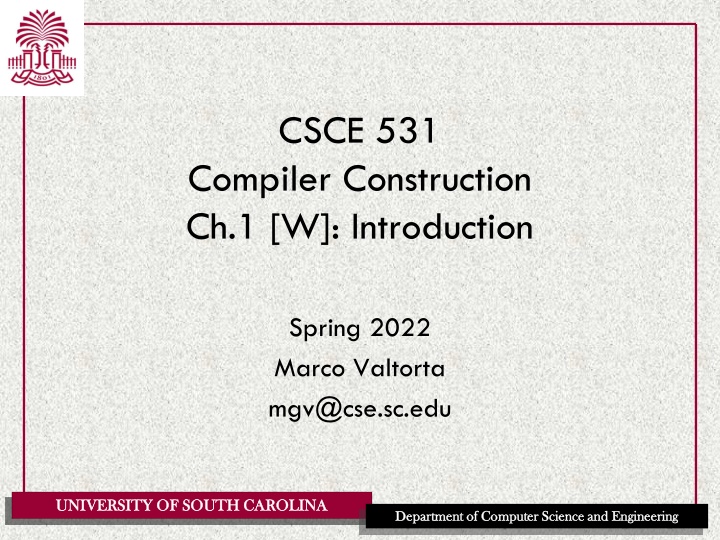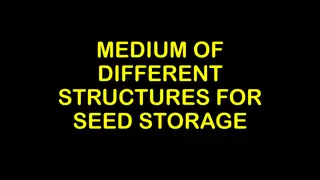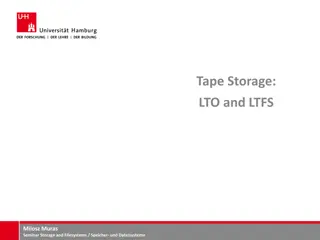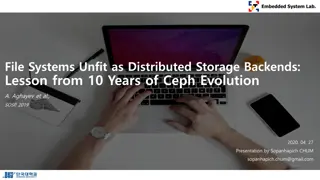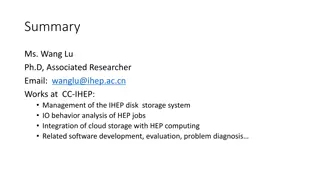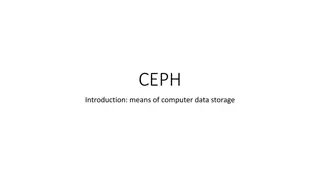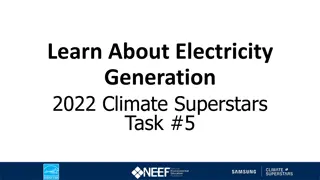Impact of Storage Efficiency on Electricity Market Profitability
The impact of storage efficiency and charging costs on storage profitability in the electricity market. Learn about levelized cost of electricity and storage, along with additional metrics and storage parameters used for illustration.
Uploaded on Apr 13, 2025 | 0 Views
Download Presentation

Please find below an Image/Link to download the presentation.
The content on the website is provided AS IS for your information and personal use only. It may not be sold, licensed, or shared on other websites without obtaining consent from the author.If you encounter any issues during the download, it is possible that the publisher has removed the file from their server.
You are allowed to download the files provided on this website for personal or commercial use, subject to the condition that they are used lawfully. All files are the property of their respective owners.
The content on the website is provided AS IS for your information and personal use only. It may not be sold, licensed, or shared on other websites without obtaining consent from the author.
E N D
Presentation Transcript
CSCE 531 Compiler Construction Ch.1 [W]: Introduction Spring 2022 Marco Valtorta mgv@cse.sc.edu UNIVERSITY OF SOUTH CAROLINA UNIVERSITY OF SOUTH CAROLINA Department of Computer Science and Engineering Department of Computer Science and Engineering
Levels of Programming Languages class Triangle { ... float surface() return b*h/2; } High-level program LOAD r1,b LOAD r2,h MUL r1,r2 DIV r1,#2 RET Low-level program (in an assembly language) Executable machine code ( a string of bits) 0001001001000101 0010010011101100 10101101001... UNIVERSITY OF SOUTH CAROLINA UNIVERSITY OF SOUTH CAROLINA Department of Computer Science and Engineering Department of Computer Science and Engineering
Machine Code and Assembly A machine code program(or just machine code ) is a sequence of instructions, where each instruction is a bit string that is interpreted by the machine to perform an operation The process of translating each instruction into machine code is called assembly Machine languages and assembly languages are low-level languages However, the notion of low- and high-level is relative UNIVERSITY OF SOUTH CAROLINA UNIVERSITY OF SOUTH CAROLINA Department of Computer Science and Engineering Department of Computer Science and Engineering
Features of High-Level Languages Expressions Data types Control structures Declarations Control abstraction (via routines) Data abstraction (via encapsulation) UNIVERSITY OF SOUTH CAROLINA UNIVERSITY OF SOUTH CAROLINA Department of Computer Science and Engineering Department of Computer Science and Engineering
Declarations, Expressions, Commands A command is executed to update variables and perform I/O An expression is evaluated to yield a value A declaration is elaborated (at compile time) to produce bindings. It may also have the side effect of allocating and initializing variables UNIVERSITY OF SOUTH CAROLINA UNIVERSITY OF SOUTH CAROLINA Department of Computer Science and Engineering Department of Computer Science and Engineering
Language Translation A source program in some source language is translated into an object program in some target language An assembler translates from assembly language to machine language A compiler translates from a high-level language into a low-level language the compiler is written in its implementation language An interpreter is a program that accepts a source program and runs it immediately An interpretive compiler translates a source program into an intermediate language, and the resulting object program is then executed by an interpreter UNIVERSITY OF SOUTH CAROLINA UNIVERSITY OF SOUTH CAROLINA Department of Computer Science and Engineering Department of Computer Science and Engineering
Programming in the Large UNIVERSITY OF SOUTH CAROLINA UNIVERSITY OF SOUTH CAROLINA Department of Computer Science and Engineering Department of Computer Science and Engineering
Syntax Specification Syntax is specified using Context Free Grammars: A finite set of terminal symbols A finite set of non-terminal symbols A start symbol A finite set of production rules Usually CFG are written in Backus-Naur Form (or Backus Normal Form) or BNF notation. A production rule in BNF notation is written as: N ::= where N is a non terminal and a sequence of terminals and non-terminals N ::= is an abbreviation for several rules with N on the left-hand side. UNIVERSITY OF SOUTH CAROLINA UNIVERSITY OF SOUTH CAROLINA Department of Computer Science and Engineering Department of Computer Science and Engineering
Syntax Specification A CFG defines a set of strings. This is called the language of the CFG. Example: Start ::= Letter | Start Letter | Start Digit Letter ::= a | b | c | d | ... | z Digit ::= 0 | 1 | 2 | ... | 9 Q: What is the language defined by this grammar? Note: see the first correction on the errata sheet for the textbook concerning the set of letters in Mini-Triangle. UNIVERSITY OF SOUTH CAROLINA UNIVERSITY OF SOUTH CAROLINA Department of Computer Science and Engineering Department of Computer Science and Engineering
Syntax of Mini Triangle Mini triangle is a very simple Pascal-like programming language. An example program: Declarations !This is a comment. let const m ~ 7; var n in begin n := 2 * m * m ; putint(n) end Expression Command UNIVERSITY OF SOUTH CAROLINA UNIVERSITY OF SOUTH CAROLINA Department of Computer Science and Engineering Department of Computer Science and Engineering
Syntax of Mini Triangle Program ::= single-Command single-Command ::= V-name := Expression | Identifier ( Expression ) | if Expression then single-Command else single-Command | while Expression do single-Command | let Declaration in single-Command | begin Command end Command ::= single-Command | Command ; single-Command ... UNIVERSITY OF SOUTH CAROLINA UNIVERSITY OF SOUTH CAROLINA Department of Computer Science and Engineering Department of Computer Science and Engineering
Syntax of Mini Triangle (continued) Expression ::= primary-Expression | Expression Operator primary-Expression primary-Expression ::= Integer-Literal | V-name | Operator primary-Expression | ( Expression ) V-name ::= Identifier Identifier ::= Letter | Identifier Letter | Identifier Digit Integer-Literal ::= Digit | Integer-Literal Digit UNIVERSITY OF SOUTH CAROLINA UNIVERSITY OF SOUTH CAROLINA Operator ::= + | - | * | / | < | > | = Department of Computer Science and Engineering Department of Computer Science and Engineering
Syntax of Mini Triangle Declaration ::= single-Declaration | Declaration ; single-Declaration single-Declaration ::= const Identifier ~ Expression | var Identifier : Type-denoter Type-denoter ::= Identifier Comment ::= ! CommentLine eol CommentLine ::= Graphic CommentLine Graphic ::= any printable character or space UNIVERSITY OF SOUTH CAROLINA UNIVERSITY OF SOUTH CAROLINA Department of Computer Science and Engineering Department of Computer Science and Engineering
Syntax Trees A syntax tree is an ordered labeled tree such that: a) terminal nodes (leaf nodes) are labeled by terminal symbols b) non-terminal nodes (internal nodes) are labeled by non terminal symbols. c) each non-terminal node labeled by N has children X1,X2,...Xn (in this order) such that N := X1,X2,...Xn is a production. UNIVERSITY OF SOUTH CAROLINA UNIVERSITY OF SOUTH CAROLINA Department of Computer Science and Engineering Department of Computer Science and Engineering
Syntax Trees Example: 1 2 3 Expression ::= Expression Op primary-Exp Expression Expression 1 Expression 3 primary-Exp primary-Exp. primary-Exp. V-name V-name 2 Ident Op Int-Lit Op Ident + 10 * d d UNIVERSITY OF SOUTH CAROLINA UNIVERSITY OF SOUTH CAROLINA Department of Computer Science and Engineering Department of Computer Science and Engineering
Concrete and Abstract Syntax The previous grammar specified the concrete syntax of Mini-Triangle. The concrete syntax is important for the programmer who needs to know exactly how to write syntactically well- formed programs. The abstract syntax omits irrelevant syntactic details and only specifies the essential structure of programs. Example: different concrete syntaxes for an assignment v := e (set! v e) e -> v v = e UNIVERSITY OF SOUTH CAROLINA UNIVERSITY OF SOUTH CAROLINA Department of Computer Science and Engineering Department of Computer Science and Engineering
Contextual Constraints Syntax rules alone are not enough to specify the format of well-formed programs. Example 1: let const m~2 in m + x Undefined! Scope Rules Example 2: let const m~2 ; var n:Boolean in begin n := m<4; n := n+1 end Type Rules Type error! UNIVERSITY OF SOUTH CAROLINA UNIVERSITY OF SOUTH CAROLINA Department of Computer Science and Engineering Department of Computer Science and Engineering
Scope Rules Scope rules regulate visibility of identifiers. They relate every applied occurrence of an identifier to a binding occurrence Example 1 let const m~2; var r:Integer in r := 10*m ? Binding occurence Example 2: let const m~2 in m + x Applied occurence Terminology: Static binding vs. dynamic binding See Example 1.6 (pp.16-17) in [W]. UNIVERSITY OF SOUTH CAROLINA UNIVERSITY OF SOUTH CAROLINA Department of Computer Science and Engineering Department of Computer Science and Engineering
Type Rules Type rules regulate the expected types of arguments and types of returned values for the operations of a language. Examples Type rule of < : E1<E2 is type correct and of type Boolean if E1 and E2 are type correct and of type Integer Type rule of while: whileE doC is type correct if E is of type Booleanand C is type correct Terminology: Static typing vs. dynamic typing UNIVERSITY OF SOUTH CAROLINA UNIVERSITY OF SOUTH CAROLINA Department of Computer Science and Engineering Department of Computer Science and Engineering
Semantics Specification of semantics is concerned with specifying the meaning of well-formed programs. Terminology: Expressions are evaluated and yield values (and may or may not perform side effects) Commands are executed and perform side effects. Declarations are elaborated to produce bindings Side effects: change the values of variables perform input/output UNIVERSITY OF SOUTH CAROLINA UNIVERSITY OF SOUTH CAROLINA Department of Computer Science and Engineering Department of Computer Science and Engineering
Semantics Example: The (informally specified) semantics of commands in mini Triangle. Commands are executed to update variables and/or perform input/output. The assignment command V:=E is executed as follows: first the expression E is evaluated to yield a value v then v is assigned to the variable named V The sequential command C1;C2 is executed as follows: first the command C1 is executed then the command C2 is executed, Etc. UNIVERSITY OF SOUTH CAROLINA UNIVERSITY OF SOUTH CAROLINA Department of Computer Science and Engineering Department of Computer Science and Engineering
Semantics Example: The semantics of expressions. An expression is evaluated to yield a value. An (integer literal expression) IL yields the integer value of IL The (variable or constant name) expression V yields the value of the variable or constant named V The (binary operation) expression E1 O E2 yields the value obtained by applying the binary operation O to the values yielded by (the evaluation of) expressions E1 and E2 etc. UNIVERSITY OF SOUTH CAROLINA UNIVERSITY OF SOUTH CAROLINA Department of Computer Science and Engineering Department of Computer Science and Engineering
Semantics Example: The semantics of declarations. A declaration is elaborated to produce bindings. It may also have the side effect of allocating (memory for) variables. The constant declaration const I~E is elaborated by binding the identifier value I to the value yielded by E The constant declaration var I:T is elaborated by binding I to a newly allocated variable, whose initial value is undefined. The variable will be deallocated on exit from the let block containing the declaration. The sequential declaration D1;D2 is elaborated by elaborating D1 followed by D2 combining the bindings produced by both. D2 is elaborated in the environment of the sequential declaration overlaid by the bindings produced by D1 UNIVERSITY OF SOUTH CAROLINA UNIVERSITY OF SOUTH CAROLINA Department of Computer Science and Engineering Department of Computer Science and Engineering
